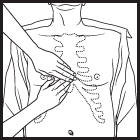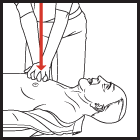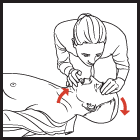Emergency Medical Response
"There's always been a real concern, around the mouth-to-mouth piece, about safety and infections."
"People do want to help -- it's not necessarily a question of not wanting to help. It's just this idea of being that close to somebody. [Some people worry about] doing it right [but more about personal risk]."
"[CPR {cardiopulmonary resuscitation} training takes place in] lovely clean rooms, using very clean, asexual mannequins [bearing little resemblance to the messiness of real-life situations]."
"Some of the people we talked to [in the research process] just really couldn't imagine even getting close enough to understand if the person had had a cardiac arrest."
"I'm not sure that people actually understand that, if you don't do something, the person will die."
Katie Dainty, scientist, Li Ka Shing Knowledge Institute, St.Michael's Hospital, Toronto

CPR IN THREE SIMPLE STEPS
(Please try to attend a CPR training course)
| 1. CALL Check the victim for unresponsiveness. If the person is not responsive and not breathing or not breathing normally. Call 911 and return to the victim. If possible bring the phone next to the person and place on speaker mode. In most locations the emergency dispatcher can assist you with CPR instructions. |  |
| 2. PUMP
If the victim is still not breathing normally, coughing or moving, begin chest compressions. Push down in the center of the chest 2-2.4 inches 30 times. Pump hard and fast at the rate of 100-120/minute, faster than once per second. |
  |
| 3. BLOW Tilt the head back and lift the chin. Pinch nose and cover the mouth with yours and blow until you see the chest rise. Give 2 breaths. Each breath should take 1 second. |  |
CONTINUE WITH 30 PUMPS AND 2 BREATHS UNTIL HELP ARRIVES
| |
In 2010 new guidelines were published recommending that witnesses to an adult collapse with no training, set aside "rescue breaths" that always alternated with chest compressions, and just focus on achieving rapid and deep chest compressions. Evidence failed to support the continuation of the original CPR methodology that used both chest compressions and mouth-to-mouth resuscitation. All of which would make it easier for bystanders to make the decision to help someone in distress.
A survey recently published in an issue of the Canadian Journal of Emergency Medicine found that Canadians and in particular women feel more comfortable employing hands-only CPR and side-stepping the breathing element requiring mouth-to-mouth contact. That our impulse to be of assistance in emergency situations is tempered hugely by just who it is who is experiencing that distress. If it's someone known, a family member, a friend, a neighbour, chances are good intervention will take place. If it's a stranger, and more precisely someone who looks unclean or down-and-out, people are more inclined to hang back.
Fifty percent of those interviewed stated they would be prepared to make the attempt to save the life of a stranger or someone of a decidedly unkempt appearance. Most of the people surveyed were unable to recognize a cardiac arrest, and only 41 percent knew that cardiac arrest equates with a heart that has stopped beating, while 21 percent confused cardiac arrest with a heart attack (where the heart hasn't stopped). And, as far as awareness of the simpler new CR guidelines, only 14 percent knew of them.
Most people thought that 50 percent or more of people in cardiac arrest would survive outside a hospital where immediate attention would be given, whereas the more accurate rate of survival is about eight percent. Annually in Canada, roughly 40,000 out-of-hospital cardiac arrests occur. Early CPR intervention and defibrillation is capable of increasing survival opportunities by 75 percent or more.
The primary drawback for people witnessing such an event and holding back from the impulse to help is fear of contracting an infectious disease with mouth-to-mouth contact. Even so, the actual risk of infection is remote. The Toronto researchers, lead author Dr. Dainty and graduate student Lindsay Cheskes [polled 428 adults who were asked among other things how they would react in various hypothetical situations.
If the victim happened to be a family member or a friend the willingness to perform cardiopulmonary resuscitation followed through, but when the person requiring assistance was a stranger 55 percent admitted to willingness to perform hands-only CPR as opposed to mouth-to-mouth, at 39 percent Even so, only 58 percent were willing to undertake compression-only resuscitation if the person in need fell into an "unkempt/homeless" category.
Finally, 28 percent of those questioned stated they would be prepared to perform mouth-to-mouth on the "unkempt/homeless". As for the new guidelines, the emphasis is on pushing hard and fast at the centre of the chest, squarely between the nipples, at a rate of 100 compressions per minute, with no concern about breaking ribs; they would heal, the situation if left unchecked would not.
*Agonal respirations are an inadequate pattern of breathing associated with extreme physiological distress, particularly periarrest states (that is, it is usually seen just prior to cardiac arrest, as well as during and for some time after). Although not always seen during arrest, it is not uncommon, and there is some evidence that it may be associated with better outcomes than arrests without agonal breathing. Whatever the case, it can easily be confused for ordinary respiration, leading to the mistaken impression that the “breathing” patient must also have a pulse; this confusion is part of why the American Heart Association no longer recommends checking for breathing as part of layperson’s CPR.
EMS Basics
Labels: Bioscience, Health, Human Relations

0 Comments:
Post a Comment
<< Home